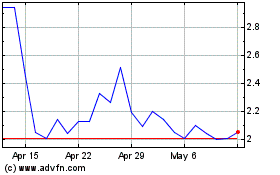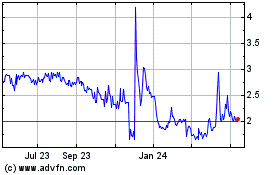Alterity Therapeutics (ASX: ATH, NASDAQ: ATHE) (“Alterity” or “the
Company”), a biotechnology company dedicated to developing disease
modifying treatments for neurodegenerative diseases, today
announced that important new data on its lead drug candidate ATH434
was presented at the World Orphan Drug Congress USA 2024 in Boston,
MA.
The poster, entitled, “Biophysical
Characteristics of ATH434, a Unique Iron-Targeting Drug for
Treating Friedreich’s Ataxia”, was presented by Ashley Pall,
Department of Pharmaceutical Sciences at Wayne State University.
The study evaluated the ability of ATH434 to target the toxic form
of iron that drives the pathology of Friedreich’s Ataxia, a rare
neurodegenerative disease that affects young children to young
adults. The study also evaluated traditional iron chelators that
are designed to bind iron and remove iron from the body.
Conversely, an iron chaperone is designed to bind and redistribute
iron within the body.
“This investigation provides important insights
into the mechanism of action of ATH434, namely that it selectively
targets the labile iron implicated in the pathology of important
neurodegenerative diseases. In this way, ATH434 behaves like a
chaperone to redistribute iron within the body. There has
historically been great interest in targeting iron in general to
treat these diseases, and we now have clear evidence that ATH434 is
very different from traditional iron chelators,” said, David
Stamler, M.D., Chief Executive Officer of Alterity.
Specifically, the study investigated how
strongly ATH434 or traditional iron chelators bind the two forms of
cellular iron: ferric iron, the stored form, or ferrous iron, the
form required for vital cellular functions such as energy
production. In excess, the ferrous or “labile” iron can also
promote oxidative stress in diseases like Friedreich’s Ataxia as it
does in Parkinson’s disease and Multiple System Atrophy.
Dr. Stamler continued, “The genetic defect in
Friedreich’s Ataxia leads to reduced function of frataxin, a
protein necessary for utilizing labile iron, thus leading to iron
accumulation in disease. By acting as an iron chaperone, ATH434 has
potential to reduce labile iron levels and thus slow disease
progression. Given these new data, we are excited to evaluate FA as
a potential new indication for ATH434.”
The novel iron binding properties of ATH434
presented in the poster support the characterization of ATH434 as
an iron chaperone based on properties it shares with endogenous
iron chaperones such as frataxin and poly-C binding proteins. These
include its low micromolar binding affinity for ferrous iron and a
bound structure that may allow for transfer of ferrous iron
proteins involved in cellular function. The new data also confirmed
that ATH434 has a dramatically lower affinity for ferric iron than
traditional iron chelators that are approved for treating systemic
iron overload. Together, these properties suggest that ATH434 has
the capacity to selectively target pathogenic ferrous iron without
impairing normal cellular iron trafficking or functions.
The poster presentation can be found on
Alterity’s website here.
About ATH434
Alterity’s lead candidate, ATH434, is an oral
agent designed to inhibit the aggregation of pathological proteins
implicated in neurodegeneration. ATH434 has been shown
preclinically to reduce α-synuclein pathology and preserve neuronal
function by restoring normal iron balance in the brain. As an iron
chaperone, it has excellent potential to treat Parkinson’s disease
as well as various Parkinsonian disorders such as Multiple System
Atrophy (MSA). ATH434 successfully completed Phase 1 studies
demonstrating the agent is well tolerated and achieved brain levels
comparable to efficacious levels in animal models of MSA. ATH434 is
currently being studied in two clinical trials: Study ATH434-201 is
a randomized, double-blind, placebo-controlled Phase 2 clinical
trial in patients with early-stage MSA and Study ATH434-202 is an
open-label Phase 2 Biomarker trial in patients with more advanced
MSA. ATH434 has been granted Orphan drug designation for the
treatment of MSA by the U.S. FDA and the European Commission.
About Friedreich’s
Ataxia
Friedreich ataxia (FA) is a rare, inherited
disorder that causes progressive damage to the nervous system. In
the brain, the cerebellum, part of the brain that coordinates
balance and movement, is most affected. FA also may cause heart
disease, specifically cardiomyopathy, and diabetes. Symptoms
typically begin between the ages of five and 15, although they
sometimes appear after age 25. While progression of FA varies
from person to person, generally individuals with FA may need to
use a wheelchair within 10 to 20 years after the appearance of
symptoms. In later stages of the disorder, people may become
completely incapacitated. There is no cure for the disorder, and
heart disease is the most common cause of death in people with
FA.1
1Source: National Institutes of Health –
National Institute of Neurological Disorders and Stroke
About Alterity Therapeutics
Limited
Alterity Therapeutics is a clinical stage
biotechnology company dedicated to creating an alternate future for
people living with neurodegenerative diseases. The Company’s
lead asset, ATH434, has the potential to treat various Parkinsonian
disorders and is currently being evaluated in two Phase 2 clinical
trials in Multiple System Atrophy. Alterity also has a broad drug
discovery platform generating patentable chemical compounds to
treat the underlying pathology of neurological diseases. The
Company is based in Melbourne, Australia, and San Francisco,
California, USA. For further information please visit the Company’s
web site at www.alteritytherapeutics.com.
Authorisation & Additional informationThis
announcement was authorized by David Stamler, CEO of Alterity
Therapeutics Limited.
Investor and Media Contacts:
AustraliaHannah
Howlettwe-aualteritytherapeutics@we-worldwide.com+61 450 648
064
U.S.Remy Bernardaremy.bernarda@iradvisory.com
+1 (415) 203-6386
Forward Looking Statements
This press release contains "forward-looking
statements" within the meaning of section 27A of the Securities Act
of 1933 and section 21E of the Securities Exchange Act of 1934. The
Company has tried to identify such forward-looking statements by
use of such words as "expects," "intends," "hopes," "anticipates,"
"believes," "could," "may," "evidences" and "estimates," and other
similar expressions, but these words are not the exclusive means of
identifying such statements.
Important factors that could cause actual
results to differ materially from those indicated by such
forward-looking statements are described in the sections titled
“Risk Factors” in the Company’s filings with the SEC, including its
most recent Annual Report on Form 20-F as well as reports on Form
6-K, including, but not limited to the following: statements
relating to the Company's drug development program, including, but
not limited to the initiation, progress and outcomes of clinical
trials of the Company's drug development program, including, but
not limited to, ATH434, and any other statements that are not
historical facts. Such statements involve risks and uncertainties,
including, but not limited to, those risks and uncertainties
relating to the difficulties or delays in financing, development,
testing, regulatory approval, production and marketing of the
Company’s drug components, including, but not limited to, ATH434,
the ability of the Company to procure additional future sources of
financing, unexpected adverse side effects or inadequate
therapeutic efficacy of the Company's drug compounds, including,
but not limited to, ATH434, that could slow or prevent products
coming to market, the uncertainty of obtaining patent protection
for the Company's intellectual property or trade secrets, the
uncertainty of successfully enforcing the Company’s patent rights
and the uncertainty of the Company freedom to operate.
Any forward-looking statement made by us in this
press release is based only on information currently available to
us and speaks only as of the date on which it is made. We undertake
no obligation to publicly update any forward-looking statement,
whether written or oral, that may be made from time to time,
whether as a result of new information, future developments or
otherwise.
Alterity Therapeutics (NASDAQ:ATHE)
Historical Stock Chart
From Apr 2024 to May 2024

Alterity Therapeutics (NASDAQ:ATHE)
Historical Stock Chart
From May 2023 to May 2024
